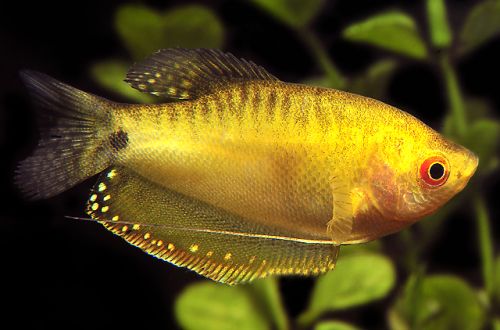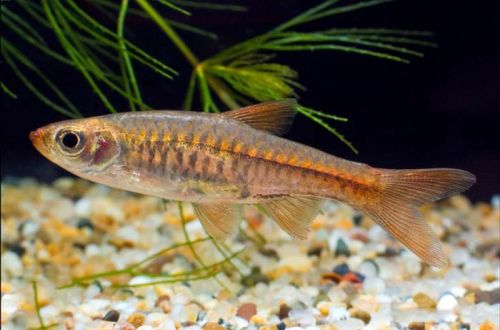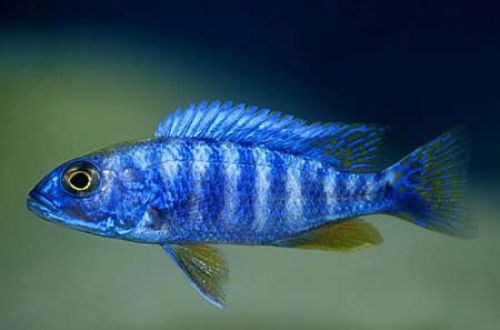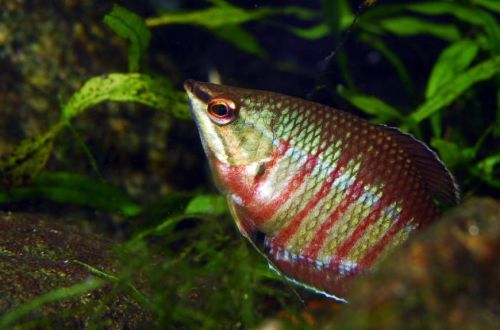
Golden Gourami
Golden Gourami, scientific name Trichopodus trichopterus, belongs to the Osphronemidae family. Beautiful saturated shades of yellow in this species are the result of artificial selection; in nature, such color forms are not found. Despite its external differences, the Golden Gourami has inherited incredible endurance from its predecessors, it is one of the most unpretentious fish that aquarists have at their disposal.

For the aquarium trade, this breeding species was bred in 1970. The breeders chose a pair with the desired coloration and fixed it for several generations, as a result, the offspring from two Golden Gourami is guaranteed to inherit the traits of their parents.
Habitat
The species is bred artificially and is perfectly adapted to the conditions of the closed space of aquariums. Does not occur in the wild.
Description
The color is golden, rich yellow. The closest relative is the Blue Gourami, so the coloration of the Golden Gourami contains familiar features – this is a spotted pattern of fins and tail, as well as dark irregular stripes along the back.
The body is elongated, somewhat compressed from the sides, the pelvic fins have transformed into filamentous processes with sensitive cells that help the fish to learn about the world around them. Like other types of gourami, a special organ is located in the oral cavity, penetrated by numerous capillaries (labyrinth organ), capable of absorbing atmospheric oxygen.
Food
They accept all types of dry industrial feed, as well as popular meat products (bloodworm, tubifex, brine shrimp, etc.). A wide variety of special feeds for Gourami are on sale, so there should not be any problems with the selection of feed.
This species has an important and useful feature, they are known as hydra exterminators – this is a tiny pest, familiar from school biology textbooks, with tentacles and stinging cells with poison. Having hydra in an aquarium creates a lot of problems, but for Gourami it is a great addition to the diet.
Maintenance and care
No special conditions or water parameters are required, fish are adapted to a wide range of pH and dH levels. The necessary equipment is a filter, positioned in such a way as to create as little current as possible, since Gourami prefer stagnant or slightly flowing waters. Also, you can not do without an aerator, a heater and a lighting system. The aquarium should be covered with a lid, an air layer with high humidity and temperature is formed under it, due to which, during the swallowing of this air by fish, the risk of damage to the labyrinth organ due to the temperature contrast becomes minimal.
Maintaining cleanliness in the aquarium is guaranteed with a weekly water renewal of at least 25% and continuous operation of the filter and aerator.
The design is arranged based on the characteristics of behavior, when keeping several Gourami, one of them becomes a dominant individual, so the rest require reliable shelters located in different parts of the aquarium. They can be either of natural origin (driftwood, heaps of stones, etc.) or artificial (wrecks, castles, etc.). Plants of any kind, arranged in groups to keep enough space for swimming. The soil is also any, dark – this helps to enhance the color.
Social behavior
Although this fish is only one of the color forms of the Blue Gourami, however, it has a more belligerent demeanor. Adult males fight each other for dominance, the loser is destined for the role of an outcast and he has to constantly hide. It is recommended to keep either a male / female pair, or only one Gourami and as neighbors representatives of other species, such as cyprinids or catfish.
When selecting neighbors, give preference to fish of similar size with a calm behavior, too active individuals are not welcome. Also avoid fish that are prone to biting fins in slow species, Gourami can suffer from them, slowness makes an excellent target out of it.
Breeding / breeding
During spawning, the male builds a nest on the surface of the water from sticky air bubbles, where eggs are subsequently deposited. If, in addition to a pair of Gourami, several more fish live in the aquarium, then a separate tank with a volume of 80 liters or more will be required for breeding. In terms of water parameters and a set of equipment, it should match the main aquarium; thickets of plants are required in the design. The only exception, the filter can be used the simplest, airlift.
The incentive for spawning is the inclusion of meat products (live or frozen) in the daily diet. After some time, when the female is visibly rounded, the pair is placed in a separate tank, where the male proceeds to build a nest, usually in a corner. Upon completion of construction, the male begins courtship – swims back and forth near the female, tail raised above his head, touches with his fins. The female lays up to 800 eggs in the nest, after which she moves back to the main aquarium, the male remains to protect the clutch, he joins the female only after the fry appear.
Diseases
In an aquarium with an established biological system and proper water parameters, there are no health problems. Deterioration of conditions, poor nutrition, contact with sick fish can provoke an outbreak of diseases. Read more about symptoms and treatments in the Aquarium Fish Diseases section.





